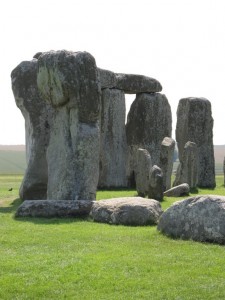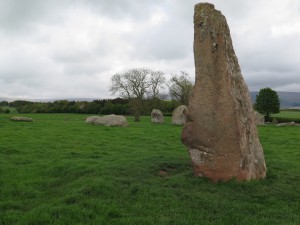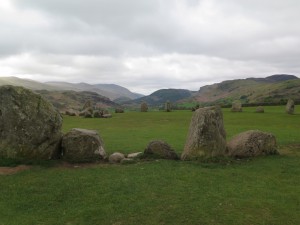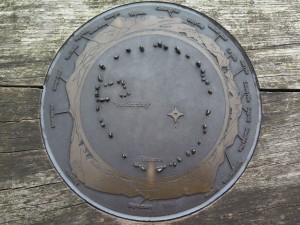 Almost 40 years ago I crossed Salisbury Plain for the first time and saw Stonehenge right there in the middle of a kind of unkempt meadow — which was how it looked at that time. It was utterly breathtaking even then, partially hidden by the exhaust fumes and solid bulk of tour buses in a pot-holed parking lot, awash with people trying to get pictures, with a scruffy little tourist shop a few yards away. In the years since then I have watched from afar as English Heritage and the National Trust have gradually created a beautiful setting for it – moving the road further away, hiding the parking lots, designing an approach for pedestrians so that you can see it now as the people who built it might have seen it when they gathered for rites and rituals. Every time I go to England, I go back. Every time. It has only become more powerful and amazing with each passing visit.
Almost 40 years ago I crossed Salisbury Plain for the first time and saw Stonehenge right there in the middle of a kind of unkempt meadow — which was how it looked at that time. It was utterly breathtaking even then, partially hidden by the exhaust fumes and solid bulk of tour buses in a pot-holed parking lot, awash with people trying to get pictures, with a scruffy little tourist shop a few yards away. In the years since then I have watched from afar as English Heritage and the National Trust have gradually created a beautiful setting for it – moving the road further away, hiding the parking lots, designing an approach for pedestrians so that you can see it now as the people who built it might have seen it when they gathered for rites and rituals. Every time I go to England, I go back. Every time. It has only become more powerful and amazing with each passing visit.
More than a decade after that first sight of Stonehenge, we found Avebury – another spectacular stone circle and henge, so large that part of the town sits right in the middle of it. You can’t see the whole circle at one time except from the air. More recently still, visiting the west of Ireland, we discovered Ardgroom and Dereenataggert and a tiny partial circle in someone’s back yard on the Beara Peninsula. And this year brought the unnamed circle above Toureen.
Then, two days ago, we stopped overnight in Penrith and saw Castlerigg and Long Meg and her Daughters for the first time.
Each circle has its unique flavor. Stonehenge with its double circle, its massive uprights and lintels, is nothing at all like Toureen and neither feel like Castlerigg. But all of them thrum with a quiet, steady presence, a sense of purpose. They do not feel inanimate to me, nor are they merely monuments from the past. They are alive in some enormously long-lived, evolving way.
And standing beside Long Meg, I began to imagine creating a stone circle of my own. We really don’t know how the circles were used – although we speculate and posit theories – nor why people were inspired to drag tons and tons of stone across more than a few miles in order to place them exactly where they stand (there are, after all, other places ley lines cross, closer to the quarries.) I began to wonder about why Stonehenge is one size and proportion and Castlerigg another. Why does one have this number of stone and others more, or less? Why is this one 40 meters across and others smaller, or larger? Why are the stones that lead to the entrance of Stonehenge smaller than the stones in the circle itself, but Long Meg is larger than any of the other stones in the circle? Why does Castlerigg have a square of stones just within the entrance of the circle?
I got a little fanciful and wondered what the stone circle of my spirit would look like. I wondered where it would sit in my inner landscape: at the base of my spine? near the belly chakra which pulses with creative energy? at the crown of my head? right around my heart?
So, if you would like to join me this week in considering the architecture of your own stone circle, here are some questions to get you started. [In the note at the bottom of the blog, I include some websites for you to consult if you would like to see different images of circles – to see how varied they can be.]
- How many stones are there in your circle? Are they uprights? or flat stones low to the ground? Do they have lintels?
- How big are they: taller than you are? small enough for you to lift them yourself? small enough to hold in the palm of your hand?
- What do the stones represent for you: milestones in your life journey? events that shaped your ethnic or family history? aspects of your personality? people?
- How big is the circle: tiny enough for you to sit in the middle and reach out to touch each stone? large enough to hold a group of friends? so large that it takes two or three minutes to walk across? bigger than a village?
- Do you have stones to mark the approach to your circle? What do they represent? Are they carved or plain?
- How is your circle aligned: to face the sun at a particular time? to observe the moon? or stars? toward a cardinal direction? toward a place of great importance for you?
- Is it intended for special events? which ones? Or is it a place you enter each day?
You may want to draw a diagram of your circle in your journal, or paint it in color, or shape it from fimo or clay (or stones!) Maybe you want to design it and ponder it for a few days (or a couple of weeks) before you set it in place in your internal landscape.
However you enter into this exercise (if you do), allow your creativity to unfold expansively. Welcome the freedom to make your circle unique to your specific context, your heart, your soul, your spiritual journey.
Here is my wish for us both:
May Gaia release her stone-strength
for the shaping of sanctuary,
marking the start of immram
and calling the wanderer home at last.
May the circle be unbroken
in love and presence,
but open to the dance of discovery.
May the stones sit deep enough to touch center
and stand tall enough to reach dreams.
May it be so.
–Andrea
Text © 2015, Andrea La Sonde Anastos
Photos © 2015 Immram Chara, LLC
Note 1: Clicking on any photo above will allow you to enlarge it.
Note 2: If you would like to see other stone circles, here are some websites:
http://www.visitcumbria.com/kes/castlerigg-stone-circle;
http://www.stone-circles.org.uk/stone/avebury.htm;
http://www.bearatourism.com/archaelogical.html


